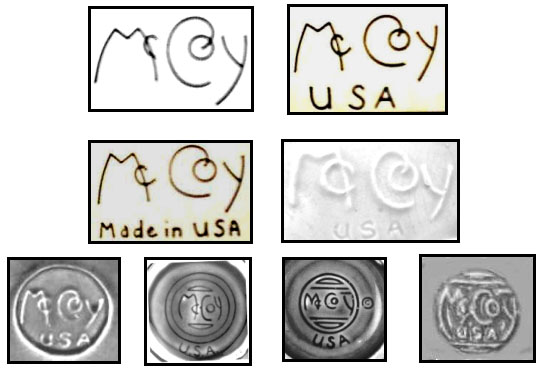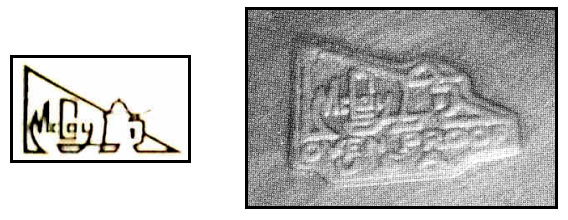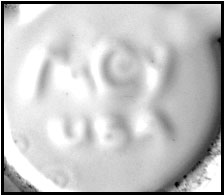The Marks used by the McCoy Potteries
By Dewayne Imsand
The J.W McCoy Pottery
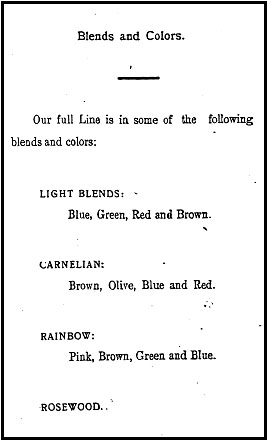 The J.W. McCoy pottery was established in Roseville, Ohio during September 1899. At this time there were 12 notable potteries already in operation in the region. Probably the most notable were; Roseville, Weller, Burley & Winter, and J.B. Owens. This gives an idea of the competitive climate J.W. became involved it, particularly when he entered the art pottery area.
The J.W. McCoy pottery was established in Roseville, Ohio during September 1899. At this time there were 12 notable potteries already in operation in the region. Probably the most notable were; Roseville, Weller, Burley & Winter, and J.B. Owens. This gives an idea of the competitive climate J.W. became involved it, particularly when he entered the art pottery area.
In the earliest years the J.W. concentrated on the production of domestic utilitarian ware. In a couple of years after the turn of the century, it seems, the production of art pottery began, but utilitarian wares were the main focus. Although there was a significant amount of this type ware produced, none has been found with a markers mark.
It is curious to note that the mark promoted the line rather than the maker. As will be seen below, this is also true of other early marks, but the policy was soon changed to include the name of the pottery.
After the turn of the century, J.W. embarked on a new undertaking – Art Pottery. J.W.’s first art pottery line is thought to be a line called “Mt. Pellee”.
Sharon & Bob Huxford, in their Collectors Encyclopedia of McCoy Pottery, list the approximate issue date of this line as 1902. The hand-scribed mark found on this line is shown above.
In April 1903, a fire destroyed the pottery, and in addition, the entire stock of pottery ready to be shipped was lost. Reconstruction began immediately, and after about seven months or so limited pottery production was achieved. But, construction continued until February 1905, which was a total of ten months before the new pottery was completed.
A company catalog, dated 1904, was issued, and it is the oldest known J.W. McCoy catalog. A section of the catalog, shown that is shown to the left is entitled, “Blends and Colors”. The layout is peculiar in that it appears to list four lines that were being produced at the time, “Light Blends”, “Carnelian”, “Rainbow”, and “Rosewood”. But “Light Blends” is probably not a line, but rather a list of the colors that were available for the pieces not in the “Carnelian”, “Rosewood” and “Rainbow” Lines.
Note that no colors were given for the “Rosewood” Line. This is also strange, however, the line is known to be characterized by a dark brown glaze, with an underlying orange color exposed in diagonal streaks. Of the three lines mentioned, only “Carnelian” and “Rosewood” have been found marked. Some typical marks found on these two lines are shown below.
It is not certain that 1904 was the first year that any of these lines were produced.
It is possible that one or more of them could have been initially produced before the 1903 fire.
In the 1904 catalog there are 66 pictures of different designs presented. It is strange that 35 of the pictures are labeled “Carnelian” pieces, 14 are labeled “Rosewood” pieces, seven are unnamed jardinières, or jardinières and pedestals, and 10 are utilitarian wares, but there are no pictures of the “Rainbow” Line. Could the reason for this be that the stock of “Rainbow” was destroyed in the fire and not available for sale in 1904? No marked pieces of this line have been found, so the “Rainbow” Line is somewhat of a mystery.
The Huxford’s list a line called the second “Rosewood” Line, and report that it first occurred in 1905. Recall that the first “Rosewood” was dark brown with diagonal orange streaks. The second “Rosewood” Line is dark brown with brownish-orange flowers in low relief. In addition, some pieces of this line have diagonal orange streaks on the reverse side.
The Huxford’s also list four new art pottery lines for 1905. They were; “Loy-Nell-Art”, “Olympia”, “Cherokee”, and “Renaissance”. How the 1905 issue date was determined is unknown, since the next known J.W. McCoy catalog is dated 1910. Although the date that these four lines were first produced may be questioned due to the lack company records, it does seem likely that the issue date falls between 1904 and before 1910. The four lines have been found marked as shown below.
The “Loy-Nel-Art” mark was at first incised by hand, but soon the mark was incised using a steel die. The “Renaissance” mark may also be found with a “M” and an overlapping “C”, as in the style of “Olympia” and “Cherokee”.
The products the J.W. McCoy pottery produced after this, and until 1910, are largely unknown. But, the 1910 catalog pictured many different lines, and a vast assortment of pieces. The following are the more decorative lines that are listed; “Red Onyx”, “Brown Onyx”, “Light Mat Green”, “Dark Mat Green”, “Old Ivory Ware”, “Corn”, “Blended Ware”, “New Marble Ware”, “Ivory”, and “White & Decorated Bristol Ware”.
But, an important bit of additional information is given in The Book of Perry County , published by The New Lexington Herald in 1909. In a section of the book the J.W. McCoy pottery is described, along with the products it was currently producing. It was reported that, “A variety of fancy, decorated and colored ware are made such as Mat Green, Loy-Nel-Art, glazed and utility ware, vases, jardinières, pedestals, umbrella receivers, cuspidors, cooking wares, jugs, fancy and high-colored flower pots, mixing bowls, combinets, stewing kettles, baking pans, and toilet ware”.
As can be seen, the pottery was still engaged in the production of numerous utilitarian stoneware in 1909, but also that the Mat Green and the Loy-Nel-Art lines were in existence at that time. Since the two art pottery lines were named and mentioned first, it appears likely that 1909 was the year the two lines were introduced.
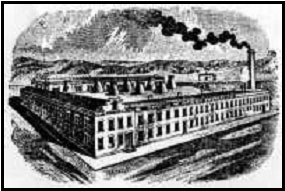 In 1910, Albert Cusick, who was the chief designer at the time, produced his first design – the Corn Line. His incised name can be found on pitcher and mug handles, or on the bottom of other pieces. His signature may also be found on some of the finest, earliest art pottery lines. This provides another means to identify J.W. McCoy, and later Brush–McCoy as the maker of the pottery.
In 1910, Albert Cusick, who was the chief designer at the time, produced his first design – the Corn Line. His incised name can be found on pitcher and mug handles, or on the bottom of other pieces. His signature may also be found on some of the finest, earliest art pottery lines. This provides another means to identify J.W. McCoy, and later Brush–McCoy as the maker of the pottery.
The J.W. McCoy Pottery Company as it appeared in 1909 is shown to the left.
The Bursh-McCoy Pottery
In November 1911, George Brush became the majority stockholder of the J.W. McCoy pottery, and in December of that year the name of the pottery was changed to the Brush-McCoy Pottery Co.
Very many of the pieces produced by the Brush-McCoy pottery, as in the case of the J.W. McCoy pottery, had no identifying marks at all. Relatively early though, the procedure of marking their wares with a style number was adopted. These solitary numbers were incised into the into the body of the ware. Two examples are below.
It appears that the management at the pottery now favored a more consistent marking of their wares with style numbers, rather than the previous policy of using line names on some pieces. It is strange that the new policy did not include the use of the pottery name.
There are only two cases in published references where the Brush-McCoy pottery used a line name. The first was in 1912, when an ink stamp was used to inform that the piece was Navarre. The second was in the 1916 Vogue Line, which was also an ink stamp. The Vogue mark was unique in that it also showed the maker – the Brush-McCoy pottery. This is the only published case where Brush-McCoy included its name in a permanent mark.
The role J.W. McCoy assumed after 1911 was basically that of a stockholder. For the last couple of years or so, a major part of J.W.’s interest was taken by helping his son Nelson, establish his own pottery, the Nelson McCoy Sanitary Stoneware Company. Also during this time, J.W.’s health was progressively failing, and finally in December 1914 he died. After his death, J.W.’s son. Nelson McCoy Sr. represented the McCoy family continued interest in the pottery. However, four years later, in 1918, the McCoy family sold their interest in the pottery.
Although George Brush owned the majority interest in the pottery since the end of 1911, the use of the McCoy name was not discontinued from the pottery name until December 1925. At that time the pottery became known as the Brush Pottery Company.
The Nelson McCoy Sanitary Stoneware Company
The Nelson McCoy Sanitary Stoneware Co. (NMSSC) was established in April 1910. During the period from then until 1918, the policy of the pottery was not to mark their wares. This was a common practice during this time, although some few potteries did mark their wares.
Then during 1918 to January 1926, the NMSSC was a member of the American Clay Products Company (ACPC). This company was formed to be a cooperative organization among eleven stoneware potteries to share incoming orders and the profits earned. Each member pottery sold exclusively through the ACPC, and it was the policy of the company not to mark their products. The Federal Government forced the company to disband in January 1926 with the claim that it restricted completion. So, from 1910, when the NMSSC became established, until to the late 1920’s (around 1927) there were no marks on the pottery.
After the ACPC’s demise, the NMSSC obviously wanted to establish their identity within the market place, so it began marking its wares, since the other ten former members of the ACPC were now strong competitors. The four marks below are the earliest known marks. The first three marks are incised (cut into the bottom of the clay body), and the last mark was a stamp that used blue ink, with the mark located on the side of the piece. The numbers inside the last three marks denote the size of the piece.
The “V1” and “V2” below are also early marks, but they are known only on a couple of pieces.
The Nelson McCoy Pottery
In the early 1930’s, the demand for stoneware, food and sanitary wares, had declined and were continuing to decrease, while the demand for decorative pieces was rapidly rising. In response, the Nelson McCoy Stoneware Co. changed its name to the
Nelson McCoy Pottery Co. This change de-emphasized stoneware production and the pottery positioned itself to accommodate the new market requirements.
In 1934, Sidney Cope was hired, and in a couple of years, he became the chief designer. The production of decorative pottery was now fast becoming the principal product. In an addition effort to gain name recognition, a new type mark came into being around this time. The mark Cope devised was simply the initials “NM”, standing for of course, Nelson McCoy. Shown below are four examples of this mark, and they were all incised. Since these marks, and in fact all of the McCoy marks, are hand drawn, there are many slight variations among them all. These slight variations have little practical value to the collector.
During the early 1940’s there was another change in the way the McCoy pottery was marked. Rather than have to read the “NM” initials and understand them to mean the Nelson McCoy pottery, the pottery began using the name “McCoy”. After all, there was no competing McCoy pottery in existence to confuse buyers.
The change however, to the new type mark, was not abrupt. Older products with their original marks continued in use until sales fell off and the products discontinued. At the same time the pottery gradually introduced new products and new marks. Therefore, at any point in time, the available products possessed a mixture of older and newer marks.
Sometimes a previously unmarked piece was reissued later with a mark, and sometimes a marked piece was re-issued without any mark. Also at times, the same piece, marked or unmarked, later be made with only USA. So identical pieces, with their reissue date sometimes years apart, can be marked in three or four different ways.
Originally, all of the marks were incised, except the one ink stamp mentioned earlier. Later the marks were embossed (raised letters). The probably reason for the change from incised to embossed was that after each use of the mold when a piece is made, a small amount of clay clings inside of it in a thin sheet. After some time the incised lines of the name in the mold become shallower and shallower. When the glaze is applied to these pieces with shallow letters, the glaze can obscure the mark. This trouble is not so apt to occur when the mark is embossed.
The eight marks shown below are a sampling of the marks used on new pottery designs beginning in the early 1940’s, and used until the late 1960’s. In addition to the marks as shown, sometimes the mark included style number of the piece. This practice became more prevalent in the later years. Although the date of the first use of a mark may be known, it is not sufficient to determine the exact date a particular piece is produced. Knowing the type mark does limit the production date to a certain period of years, but that is as much as can be generally determined.
As mentioned earlier, from time to time there were numerous slight variations in the marks issued. For example, notice the “McCoy USA” mark in the second row below and compare it to the “McCoy USA” above. In the lower mark, the initials “USA” are incised, while the word “McCoy” is embossed. The same thing occurs in the case of the “McCoy Made in USA” mark.
The “USA” and the “Made in the USA” can be located below the name, or beside the name, or above it. But, none of these variations serve a useful purpose in identifying further aspects of the pottery.
The Mount Clemens Era
In 1967, the Mount Clemens Pottery Company purchased the Nelson McCoy pottery, and it became a subsidiary of Mount Clemens. The first marks used by the new owners did not include the name “McCoy”, even though the name of the pottery was not changed. Given below are the most prominent of the marks first used by Mount Clemens during 1967.
In 1968, the pottery changed the design of the mark in recognition of the value of using the name “McCoy” on the pottery products. Besides the two following examples, as always, there are other marks with slight variations.
The Nelson McCoy pottery operated as a subsidiary of the Mount Clemens pottery for about six years.
The Lancaster Colony Corporation Era
In 1974 the Lancaster Colony Corporation (LCC) purchased the McCoy pottery. The LCC gradually abolished all the marks used during the previous six years and resumed using the name “McCoy”, in the style that was first used in the 1940’s. The LCC did however add their initials “LCC” to the mark, and typically “USA”. Given below are three of these marks. Note that both embossed and incised marks occur. As mentioned earlier, the inclusion of the style number in the mark became more prevalent with time, and it was generally included on the LCC pieces.
The Designer Accents Era
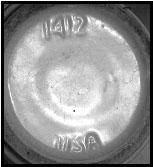 After operating the Nelson McCoy pottery for 11 years, Lancaster Colony sold the pottery to Designer Accents in 1985. The new company operated the pottery as Nelson McCoy Ceramics, however, the McCoy name was once again, absent from the mark. Shown to the left is a typical Designer Accents mark.
After operating the Nelson McCoy pottery for 11 years, Lancaster Colony sold the pottery to Designer Accents in 1985. The new company operated the pottery as Nelson McCoy Ceramics, however, the McCoy name was once again, absent from the mark. Shown to the left is a typical Designer Accents mark.
During the five years, Designer Accents operated the pottery it experienced continuing decreased sales, and finally, the company closed in the fall of 1990.
Special Marks Used By Nelson McCoy
All of the marks illustrated here in this article are typical marks found on McCoy pottery, however, there were some other marks that were used from time to time by the original and subsequent owners of the Nelson McCoy pottery. Also, as mentioned, there are a great number of pieces that were issued, all through the years, that had no mark at all. Then, there are numerous pieces that are only marked “USA”. Added to those pieces there are a few pieces that have an ink stamp reading “McCoy” or “McCoy USA”. Finally, there are a few early pieces that were marked with only a style number.
 In 1957, there was a special ink stamp issued for pieces made with a real, fired-on gold coating. The pottery used the stamp in addition to the normal “McCoy” mark that was used at the time. The stamp used liquid gold as the ink, and it reads “24 K GOLD”. The stamp is pictured to the right.
In 1957, there was a special ink stamp issued for pieces made with a real, fired-on gold coating. The pottery used the stamp in addition to the normal “McCoy” mark that was used at the time. The stamp used liquid gold as the ink, and it reads “24 K GOLD”. The stamp is pictured to the right.
Quite a few McCoy pieces are marked with the name of another company. These pieces of pottery are contract pieces made for other companies that required their own mark to be on the pieces. A few examples of the companies requiring this are CitroRamics, Esmond, and, Buckingham Ceramics.
There is another type of mark that can be called odd or unusual. For example, you can find the name “McCoy” spelled backwards, actually a mirror image. In another case, the name “McCoy” was spelled “MCOY”. To the left is a third example of an atypical mark.
Some few pieces were marked with a black ink stamp as shown here.
Through the years, the McCoy pottery designed and used maybe a dozen paper labels. These labels were generally notifications to the consumer. They would have subjects like, “Oven Proof” or “Cook – Serve” or “Hand Painted”. Sometimes on other type labels, the line name of the piece would be given. All of these labels were used in addition to a normal permanent mark.
Roseville Floraline
All of the McCoy marks shown so far were marks found on the pottery that was for sale to the general public. However, back in June 1960, the Nelson McCoy pottery established a line of pottery for sale to the florist trade. This line of pottery was called Roseville Floraline, or Floraline for short. Floraline pieces were marked with their own special mark.
The first mark shown below is an example of an original Floraline mark. The second mark is one used when Mount Clemens owned the pottery, and the last mark was used during the Lancaster Colony ownership.
There was a severe change in the Floraline marketing strategy soon after LCC took over in 1974, and the Floraline Line ended shortly thereafter.
So in summary, as you can see, the subject of marks on Nelson McCoy pottery is complex. Besides the earliest marks where symbols were used, if the mark on a piece of pottery reads “NM” or “McCoy” it was easily recognized that the piece was produced by Nelson McCoy. When the production of Floraline began, there was no question that it too was produced by Nelson McCoy. It did not matter if there were other components included with the basic mark, such as “USA”, “Made in the USA”, a style number, “MCP” or “LCC”. The additions did not change the fact that the piece is a Nelson McCoy product.
Unfortunately, today this is not always true. Recent times have brought out unscrupulous makers of reproductions and fakes. These non-authentic pieces have marks that appear to be genuine, and can fool the unsuspecting collector. Knowledge is the only safeguard against this growing threat, and collectors owe it to themselves to become educated to avoid being taken.










